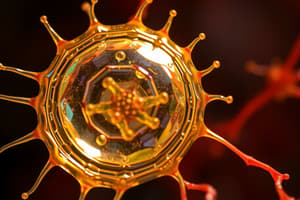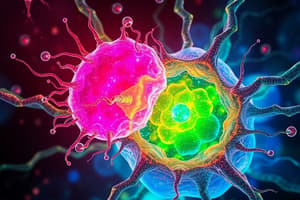Podcast
Questions and Answers
What is the cell theory's first statement regarding living things?
What is the cell theory's first statement regarding living things?
- Cells can exist independently of living things.
- All cells come from viruses.
- All living things are multicellular.
- Living things are made up of one or more cells. (correct)
What ensures the genetic continuity from generation to generation?
What ensures the genetic continuity from generation to generation?
- Metabolism
- Assimilation
- Photosynthesis
- Reproduction (correct)
In which type of reproduction do organisms duplicate an identical cell?
In which type of reproduction do organisms duplicate an identical cell?
- Genetic reproduction
- Sexual reproduction
- Asexual reproduction (correct)
- Binary fission
What do autotrophs use to produce their own glucose?
What do autotrophs use to produce their own glucose?
Which molecule is primarily responsible for carrying genetic information?
Which molecule is primarily responsible for carrying genetic information?
What is the term for the sum of all chemical reactions occurring within an organism?
What is the term for the sum of all chemical reactions occurring within an organism?
Which of the following is NOT a characteristic of life?
Which of the following is NOT a characteristic of life?
Which group of organisms cannot make their own glucose?
Which group of organisms cannot make their own glucose?
What is necessary for a unicellular organism to grow and develop?
What is necessary for a unicellular organism to grow and develop?
Which process must a multicellular organism undergo to grow and develop?
Which process must a multicellular organism undergo to grow and develop?
What is the correct sequence of biological organization from smallest to largest?
What is the correct sequence of biological organization from smallest to largest?
How do all living things respond to their environment?
How do all living things respond to their environment?
What is homeostasis in the context of living organisms?
What is homeostasis in the context of living organisms?
Who proposed the mechanism of natural selection?
Who proposed the mechanism of natural selection?
What does fitness refer to in biological terms?
What does fitness refer to in biological terms?
Which of the following statements about evolution is true?
Which of the following statements about evolution is true?
What component is critical for autotrophs to produce their own glucose during photosynthesis?
What component is critical for autotrophs to produce their own glucose during photosynthesis?
What is the primary distinction between unicellular and multicellular organisms?
What is the primary distinction between unicellular and multicellular organisms?
What do heterotrophs require to acquire energy?
What do heterotrophs require to acquire energy?
What must unicellular organisms increase in order to grow and develop?
What must unicellular organisms increase in order to grow and develop?
Which of the following best describes the term 'metabolism'?
Which of the following best describes the term 'metabolism'?
What process must multicellular organisms undergo to ensure growth?
What process must multicellular organisms undergo to ensure growth?
How can genetic information be classified in living organisms?
How can genetic information be classified in living organisms?
How do all living things respond to changes in their environment?
How do all living things respond to changes in their environment?
What term refers to the ability of an organism to maintain a stable internal environment?
What term refers to the ability of an organism to maintain a stable internal environment?
Which type of reproduction involves the combination of sperm and egg?
Which type of reproduction involves the combination of sperm and egg?
What is the purpose of reproduction in living organisms?
What is the purpose of reproduction in living organisms?
What mechanism did Charles Darwin propose to explain evolution?
What mechanism did Charles Darwin propose to explain evolution?
What characteristic distinguishes viruses from living organisms?
What characteristic distinguishes viruses from living organisms?
What is indicated by the term 'fitness' in biological terms?
What is indicated by the term 'fitness' in biological terms?
What term describes the changes that living organisms undergo over time?
What term describes the changes that living organisms undergo over time?
Which level of organization is the most complex for living organisms?
Which level of organization is the most complex for living organisms?
Flashcards
Characteristics of Life
Characteristics of Life
The common features shared by all living organisms, regardless of their size, complexity, or environment.
Cell Theory
Cell Theory
The fundamental concept stating that all living things are composed of cells, cells come from pre-existing cells, and the cell is the basic unit of life.
Reproduction
Reproduction
The biological process by which living organisms create offspring to ensure the continuity of their genetic information.
Sexual Reproduction
Sexual Reproduction
Signup and view all the flashcards
Asexual Reproduction
Asexual Reproduction
Signup and view all the flashcards
DNA/RNA
DNA/RNA
Signup and view all the flashcards
Autotrophs
Autotrophs
Signup and view all the flashcards
Heterotrophs
Heterotrophs
Signup and view all the flashcards
Unicellular organism growth
Unicellular organism growth
Signup and view all the flashcards
Multicellular organism growth
Multicellular organism growth
Signup and view all the flashcards
Levels of Biological Organization
Levels of Biological Organization
Signup and view all the flashcards
Organism Response to Environment
Organism Response to Environment
Signup and view all the flashcards
Homeostasis
Homeostasis
Signup and view all the flashcards
Evolution
Evolution
Signup and view all the flashcards
Natural Selection
Natural Selection
Signup and view all the flashcards
Fitness
Fitness
Signup and view all the flashcards
What are living things made of?
What are living things made of?
Signup and view all the flashcards
Where do cells come from?
Where do cells come from?
Signup and view all the flashcards
What is the purpose of reproduction?
What is the purpose of reproduction?
Signup and view all the flashcards
What are the two main types of reproduction?
What are the two main types of reproduction?
Signup and view all the flashcards
What is DNA?
What is DNA?
Signup and view all the flashcards
How do autotrophs get energy?
How do autotrophs get energy?
Signup and view all the flashcards
How do heterotrophs get energy?
How do heterotrophs get energy?
Signup and view all the flashcards
What is metabolism?
What is metabolism?
Signup and view all the flashcards
What makes a unicellular organism grow?
What makes a unicellular organism grow?
Signup and view all the flashcards
How do multicellular organisms grow?
How do multicellular organisms grow?
Signup and view all the flashcards
What is the hierarchy of life?
What is the hierarchy of life?
Signup and view all the flashcards
How do organisms respond to their environment?
How do organisms respond to their environment?
Signup and view all the flashcards
What is homeostasis?
What is homeostasis?
Signup and view all the flashcards
What is evolution?
What is evolution?
Signup and view all the flashcards
What is natural selection?
What is natural selection?
Signup and view all the flashcards
What is fitness?
What is fitness?
Signup and view all the flashcards
Study Notes
Characteristics of Life
- Living things exhibit similar characteristics, whether simple or complex
- All living things are composed of cells
- Cell Theory:
- Living organisms are made of one or more cells
- All cells originate from pre-existing cells
- The cell is the basic unit of life
- All living things reproduce
- Reproduction creates offspring, ensuring genetic continuity
- Two types of reproduction: sexual (involving sperm and egg) and asexual (duplication of a cell)
- Genetic information is encoded in DNA, a molecule of deoxyribonucleic acid.
- Viruses can have DNA or RNA (in retroviruses) as their genetic material, but viruses do not exhibit all characteristics of life and are thus classified as non-living.
- All living things require and use energy:
- Autotrophs (e.g., plants) create their own energy (glucose) through photosynthesis using chlorophyll and sunlight.
- Heterotrophs (e.g., animals) obtain energy by consuming other organisms.
- Energy usage is facilitated by chemical reactions known as metabolism.
- All living things grow and develop
- Unicellular organisms increase in size by gaining more cytosol
- Multicellular organisms grow by cell division and specialization into tissues.
- Living things are organized on multiple levels, from atoms to organ systems
- Living beings react to changes ('stimuli') in their surroundings
- Responses can adjust external or internal environments.
- Homeostasis (constant internal state) is maintained through these responses.
- Living things adapt and evolve through time.
- Natural selection is the process by which traits that promote survival and reproduction are favoured.
- Random mutations in DNA create variability in traits that result in differences amongst individuals.
Studying That Suits You
Use AI to generate personalized quizzes and flashcards to suit your learning preferences.




